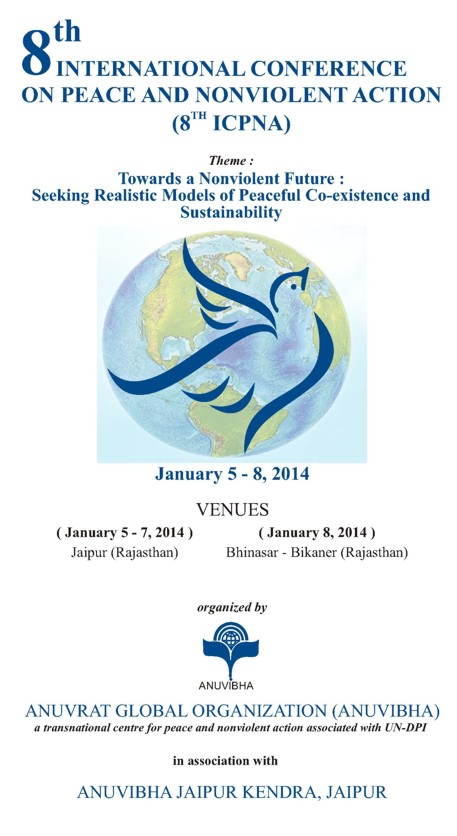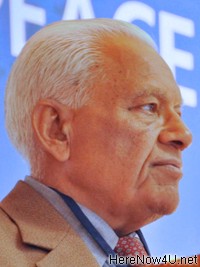 | 8th International Conference on Peace and Nonviolent Action |
Training and Group Sharing Initiatives at Balodaya (Peace Palace, Anuvrat Vishwa Bharati, Rajsamand, Rajasthan, India)
Confucius conceived moral development as similar to the production of a precious stone: “We are like raw uncut gems, and our potential is carved and polished in the best possible way.”
For a human being Nonviolence is a competency, which can be learned and improved. A competency is a combination of knowledge, skills, and attitudes for superior performance. Being surrounded with violence all around, the nonviolent state of mind definitely requires superior efforts.
Nonviolence is similar to other virtues, like wisdom, courage etc. To maintain our existence in the society in a most appropriate manner, we develop certain rational as well as moral standards leading to Human Excellence. These standards are called moral values and vary country-to-country and religion-to-religion. Most moral values are punishment-based rather than meant to further the development of human beings. It is therefore no wonder that nonviolence has a somewhat different meaning in Jainism, Buddhism or Hinduism. But they have one thing in common: they all have faith in the development of the human soul.
Avoiding all these traps, I simply state: Nonviolence is a way of life, flowing naturally from within, willingly and carefully chosen by an individual. It is a responsibility which one undertakes to guide one’s life based on principles.
The million dollar question is, “Why nonviolence and how do we learn it?” The answer is simple. Non-violence is essential to create harmony and the possibility of positive and pleasant co-existence among the human race for its development.
Can we learn non-violence? Yes, we can. To learn non-violence we need to loosen our mental ties. The concepts of Hinduism, Jainism, Buddhism, Christianity and many others are deeply rooted in our polluted minds and the logic against nonviolence appears in attractive shapes and reasonings, connecting it with one particular school of thought and it tries its best to undermine the concept. So, the answer is: first do soul-searching, and then create space in the mind allowing fresh air to enter in. It is a bloodless surgery with one’s own hands on one’s own body.
The Balodaya experience is unique in this respect. The Children’s Peace Palace situated at Anuvrat Vishwa Bharti, Rajasamand is surrounded by a serene environment on a hilltop and is an excellent place to attract children. It gives them complete freedom for experiential learning.
The one, three or five days’ experience-based learning camps for children are designed in a way to create ample opportunities to develop refined feelings, emotions and to imbibe spiritual values through the path of self-exploration. The facilitators from various fields, ranging from education, sports and psychology help them to inculcate their own understanding about the world in a most appropriate way learning non-violence competency.
The traditional systems of teaching and preaching are not practiced here. We all know the limitations of such religious frameworks. Instead, ways to understand spirituality and healthy living through nature are being realized.
The first session starts with understanding fear of the unknown. Often children coming from various schools are tuned to react in a particular way acquired from their own societal setting; hence in an unfamiliar environment they do not open up, are reluctant to participate and choose to keep themselves in a cell. Hence we start the session with psychological games, which immediately channel their energy and the hidden real child comes out without hesitation. In schools of remote villages they rarely have an opportunity to speak in front of a group, or through a microphone. But here, one hour psychological games sessions helps them to bring out their real self. Almost all children become instantly motivated to follow a new behavior.
The galleries created in the Balodaya centre are aimed at giving experiential learning. Various samples of plant seeds are touched and felt by children and then a lot of questions come to the surface which are answered by showing how seeds convert into real life trees, or by showing pictures or videos.
Videos or short movies of great world leaders including spiritual leaders are shown to them. Books which are available in the library - which carries a lot of autobiographies - further support this. Children are asked to choose books as per their own interest. Teachers help them in clarifying the queries.
Yoga and asana (yoga posture) practices are supported by beautifully carved life-size statues at Balodaya and generate a lot of interest in children, and the yoga teacher helps them to understand how these impact the body and what benefits can be derived. Preksha meditation practice strengthens their inner power and they develop a peaceful state of mind. Thus they are ready for developing ‘Nonviolence Competency’.
Developing Nonviolence Competency
Violence is associated with the safety aspect of humans. Anger is natural in all species to safeguard themselves from danger. This is evident even in a newborn child. Our aim is not to eliminate anger. We focus at utilizing anger to channel it in positive energy.
The Balodaya Centre has developed various galleries backed up with light and sound which generate certain emotions and feelings in the viewers while they pass through. We ask participants to get in touch with those experiences. When they come back in group sessions, we ask them how they felt and what reaction came up in their mind in the first moment. Their sharing brings some common insight and we help them understand how our body and mind reacts with certain feelings and emotions. During our interaction with others, we generate similar emotional responses with a variety of combinations that affect our body and mind in a certain way and we become nothing but prey of fixed neural patterns repeating themselves continuously when handling interactions. We create a situation of human labs where they experience and learn to appreciate the fruits of new behavior. The painting session provides them a media where they express themselves in various colors and shapes in symbolic forms.
The concept of violence is understood in a most appropriate way through interactions and impact on others. The reflective learning helps in clarifying issues and understanding others most appropriately. One is able to make assumptions that what is driving other and from what mental state they are arriving. We help them in verifying assumptions in a learning mode, using feelings and emotion based responses.
Once they understand what makes them angry or violent they start positively changing responses and the way they react to others in different situations. It is as good as looking into a mirror and seeing oneself. Large numbers of students have been successful in bringing immediate and temporary changes in themselves due to group sessions but the sustainable impact for when they grow adult has not been validated, and this is largely due to various constraints. We have had few samples to validate whether the process has been meaningful and children could sustain what they learned at Balodaya. Boys and girls who had exposure of three days to one-week camps and also those who attended the same more than once, are greatly benefited. The one-day camps just generated curiosity.
Our experience of Balodaya is spread over two decades. The children who came at the age of 14 in this program are now at the age of 30+. The time duration is enough to assess the effectiveness of the program(s) and its content and to validate if the children have understood non-violence when they become young and adult.
There are some examples of students who are now adult and serving in good positions as professionals who said that their experience at Balodaya developed in them a sense of better citizenship and that they can deal with a variety of situations in a calm and poised manner. They also mentioned that the exposure with nature and understanding various plants, fruits and their benefits has kept them away from a number of diseases by which otherwise they could have been affected due to ignorance. Many of them still continue to do a daily walk, some form of exercise, asana and meditation practice. They also understood that there is no need to kill animals to bring food on their plate when nature has given varieties of foods and fruits in abundance.
When asked, “have you understood non-violence in the true sense?” this question led in particular to a variety of responses. A few said that not eating non-vegetarian food is nonviolence. A handful of adults accepted that violence is in the mind, in our choices and responses. Sometimes we get in touch with it and correct our responses. Sometimes we simply ignore it. Many of them accepted that they are more mature in handling emotions and feelings and relish the Balodaya experiences in inculcating it.
When asked, “How do you use nonviolence competency in day to day life?”, the common answer was in “interactions” and “handling difficult situations” where we have to take tough decisions which at first appear to be violent but in reality are not violent. (For example hurting someone in the form of monetary loss or a charge sheet or suspension because of indiscipline etc. and thus causing bad feelings in them). Decisions come out as natural course of action, without carrying bias, prejudice or anger in one’s heart, purely based on facts, behavioral observation and rationality. The aim is to give people an opportunity to improve. They affirmed that an unbiased attitude has generated respect from the same person who changed his attitude, and understood the gravity of the situation and how it affects others when one does not serve the duty one is paid for and assigned to.
Participants showed maturity in stating that being nonviolent does not mean to be sweet to everybody. They considered it as a competency required to demonstrate in letter and spirit that behind a particular behavior or response there is no angry motivation and that it is a responsible behavior. This attitude has made them successful in their career choices also. One thing that they had in common was that they were focused and to the point. There was no inner force to unnecessarily prove the point of view. It showed that they operated with wisdom in mind.
The Balodaya experience has greatly benefited me in enriching my own personality and experiences. There has never been any incidence in which I forcibly made children understand concepts. I knew over the years that learning has its own pace and every child experiences it in a different manner. With a pace of time they make their own adjustments, corrections and come out with concrete validated experiences, which lead their life. Each one is unique in himself and has a right to choose - good or bad, whatever life turns them into.
Over the years, all of us facilitators, a combination of experts from a variety of fields, have realized that there is no single path of teaching and facilitation. Each situation is new for us and we put sincere efforts to find out new options. It is true that with larger groups we sometimes face pressure of work and difficulties in interaction but this is resolved with the peer group support and by the help from students having an aptitude of facilitation. It has been a great experience for all of us and we are together on the journey of nonviolence.
Persons like Mr. Mohan Bhai Jain, Mr Sanchay Jain, Dr. S.L. Gandhi, Mr. Bernie Meyer, Mr. Balmukund Sanadhaya, Mr. N.K. Sharma, Dr. J.C. Chaudhary, Mr. Suresh Kavdiya, Mr. Chatur Kothari, have been greatly instrumental in shaping the Balodaya program and making it a reality.
 Dr. Narendra Kumar Sharma
Dr. Narendra Kumar Sharma